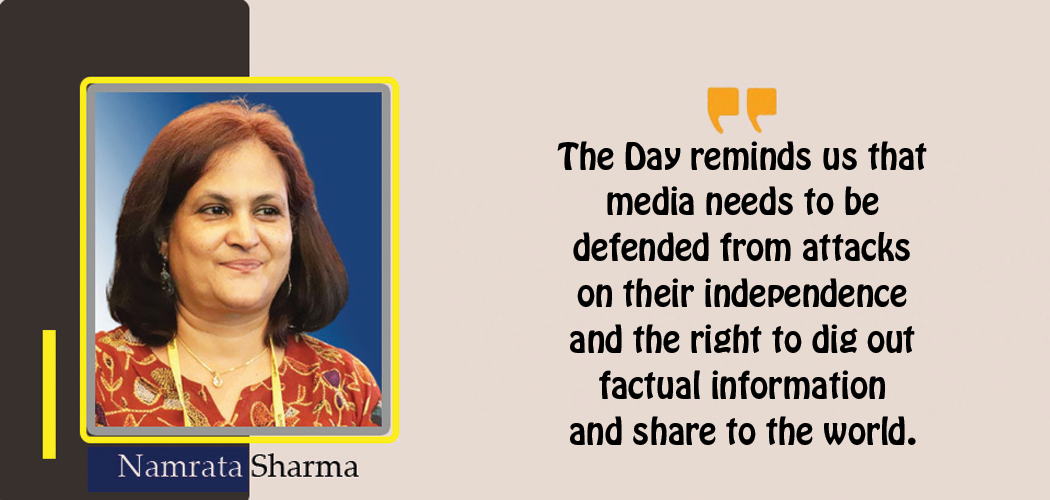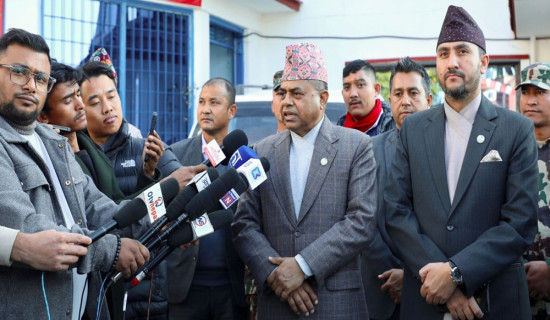- Wednesday, 24 December 2025
Press Freedom Still Faces Challenge
Namrata Sharma
May 3rd is annually celebrated as the Press Freedom Day globally as per the declaration of the UN General Assembly in 1993. This is the day to celebrate the fundamental principles of press freedom and see how it is currently in the global context. The Day reminds us that media needs to be defended from attacks on their independence and the right to dig out factual information and share to the world. This is the day for the governments and the corporate sector media owners to remember their commitments to press freedom. Media professionals also need to reflect on the issues of press freedom and professional ethics. May 3rd is also the day to remember all the journalists who have died in wars, conflicts or natural calamities while collecting news.
Many have been killed for their brave and daring work of investigating corruption, crime and all atrocities that are hidden. Uncovering the misuse of power and exposing it to the world has subjected many journalists to be killed, arrested, imprisoned, kidnapped and stripped of their jobs. According to World Press Freedom Index compiled by Reporters Without Borders (RWB) “journalism the main vaccine against disinformation” is completely or partly blocked in 73 per cent of the 180 countries ranked by the organisation. According to RWB, Nepal has dropped six places on the global press freedom index taking a place of 112 among 180 countries.
Strong pillar
The media in Nepal has always been a strong pillar in strengthening democracy. However, according to the annual World Freedom Day report published by the Freedom Forum on May 3, 2022 there were 96 cases against journalists in Nepal including 7 female journalists. There have been no efforts to address registered cases of crimes against journalists and there is an “ambiguous and over-broad provisions of the rule undermining the freedom of expression, right to broadcast and principle of open internet”.
Press freedom in Nepal was established in 1990 after the restoration of multiparty democracy. With the advent of the multiparty system, many media outlets mushroomed and several political parties registered their tabloids and weeklies, which served as their mouthpiece. After the establishment of Kantipur Publications, the mainstream private sector media took root in Nepal. Before 1990, the media comprised of government-owned print and electronic media such as The Rising Nepal, Gorkhapatra and Nepal Television. There was such hegemony that if anyone who dared to speak against the government or publish any written stuff before 1990 would be subjected to arrest and imprisonment. Working journalists during the early 1990s will surely remember the excitement of having the opportunity to write freely without restrictions from the state.
This scribe remembers a regional conference of journalists in mid 1990s where journalists from the South Asia region were flabbergasted at how open the Nepali press was because the journalists were forthrightly demanding the resignation of the then Prime Minister. They said that they would have been arrested in their countries if they did the same thing. Since then and now, there has been a major paradigm shift in the media scenario in this country. Before 1990, the Nepali media was governed only by the government, but now, apart from government ownership there are corporatised media, social media, foreign press and also media affiliated to political parties. There are more than three dozen dailies and electronic media that have coverage not only in the Kathmandu Valley but in all the seven provinces.
It is interesting to note that some of the coverage by the government media, including electronic, audio-visual and print has become more progressive over the years. Issues of misdoings within the government sectors, be it in hospitals, the construction sector and within some departments were never published or broadcast before, but now the government mouth pieces are also publishing and broadcasting such issues. During the period of absolute monarchy, journalists’ published pamphlets and messages in a underground movement to create awareness among the population to be alert to the dictatorship that came with a feudal and patriarchal system. They did this risking their lives, jobs and family safety. Many were caught for articles they dared to write.
After the 1990 political change, Nepali media was equally strong in raising the voice of the Nepali people to steer the country towards development and peace. During the civil war again journalists were under attack both by the Maoist insurgents and security agencies. There are several cases of journalists who disappeared then and were killed but no credible account and investigative reports related to this have been released by the government so far. Once more injustice was done to journalists for risking their lives to bring out the facts and truths. However, Nepali press never gave up and has always moved ahead to bring out the issues of the Nepali people and the nation and to alert authorities of corruption from various angles.
Stringent laws
Now after the country has entered a federal system, it is not an exaggeration to say the press freedom is again under threat. It is an irony that as Nepal is progressing on the path of democracy as a federal country, there are stringent laws being formulated and enacted which are curbing press freedom. The government has enacted the Electronic Transaction Act which makes it easier for journalists to be arrested and fined for articles they publish. This Act has made journalists in Nepal vulnerable to defamation charges. This is a serious state of affairs and there is a looming question as to where the country is heading regarding press freedom without which democracy is threatened.
(Sharma is a journalist and women rights advocate namrata1964@yahoo.com Twitter handle: @NamrataSharmaP )

















